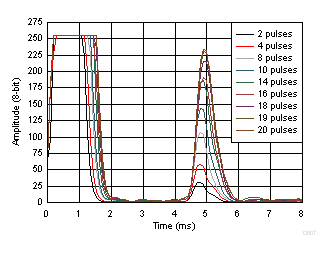SLAA732A February 2017 – April 2021 PGA460 , PGA460-Q1
5.2 Pulse Count
A trade-off exists between a large pulse count and short ringing-decay period. The larger the pulse count value, the longer the transducer excitation length, the more energy is required, and the more time the transducer spends ringing upon release. As a result, detecting short-range objects becomes difficult. However, if short-range detection is not a concern, then optimizing the point of SPL saturation of the transducer will help to preserve energy in the long term. The transducer itself cannot infinitely generate more sound pressure level by exceeding the driving voltage or pulse-count specification. Instead, if the transducer is over-supplied and over-excited, the transducer characteristics can be change and life-cycle can be reduced.
The example in Figure 5-2 shows at which point the SPL of the transducer becomes saturated because of pulse count. For this particular transducer in the example, the peak amplitude did not improve beyond 20 pulses. This transducer should not be pulsed more than twenty times per burst cycle as specified in the data sheet of the transducer.
 Figure 5-2 Pulse Count Increased from 2 to 20 to Determine Pulse-Count Limit
Figure 5-2 Pulse Count Increased from 2 to 20 to Determine Pulse-Count Limit